» Home
» About
» Membership
» Journal
» Sparoza Garden
» Branches
» MGS Forum
» Seed Exchange
» Donations
» MGS Excursions
» Information
» Members' Gardens
» Book Reviews
» News & Views
» Contact
» Search
|
The MGS Garden at Sparoza
A Diary
Occasional reports on the garden throughout the seasons of the garden, the plants and the work being undertaken.
2014 October to 2015 September
2014 January, February
2012 June
2011 January / February, April / May
2010 February, February / March, March, August, September, October / November
2009 January, Apri, May, August, September, November
2008 January, February, April, May, July, September, December
|
October 2014 to September 2015 |
Report on the MGS Garden at Sparoza given at the 2015 AGM in Ischia
Warmest greetings from Sparoza and its gardener!
Had I an Aladdin’s Lamp I would summon the genie to transport me to the volcanic island of Ischia to meet you all, see Lady Walton’s wonderful garden, hear the music and take part in all the delights arranged for this 21st General Assembly of the MGS. I would tap the lamp once more and beg the summoned genie to bring you all to see our garden here, as it is now in mid-October. I will explain.
In the last week of September we were blessed with 102 millimetres of rain – 4 inches. The nearly six months of drought was over. Such a long drought has never happened before in the 23 years I have lived here. The regeneration of the vegetation was swift: within a week the hillside, garden and phrygana were transformed from the state of dormancy to one of vibrant life. Green shoots cover the bare earth, spires of Drimia maritima, myriads of delicate Prospero autumnale, heavy rich heads of Amaryllis belladona, pale pink Zephyranthes, carpets of Cyclamen graecum, masses of Sternbergia lutea and Sternbergia sicula emerge day after day. In the garden, shrubs have burst into blossom, roses have refoliated, euphorbias and aloes have opened their ‘arms’ to the sun, lavenders and rosemaries are in flower as are many species of salvia. With the unseasonable warmth the Cercis siliquastrum trees are flowering, in confusion with their leaves. In one word it’s glorious.
Sparoza in September/October

Drimia maritima among the first signs of new life on the hillside
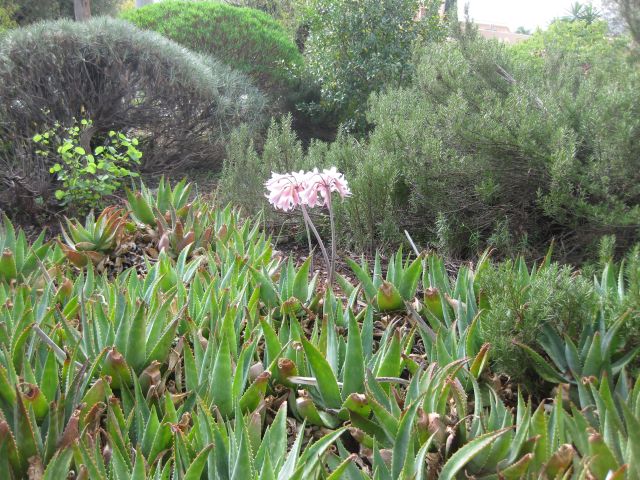
Amaryllis belladonna in the aloe bed
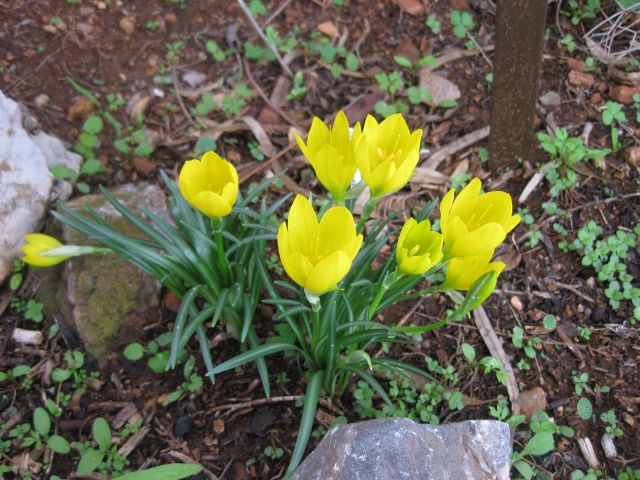
Sternbergia lutea

Carpets of Cyclamen graecum

Zephyranthes in bud
The past year in the garden has been one of steady progress and development. Daphne Ott started work in the garden in October. We did much planting of bulbs together in the phrygana, propagation tasks in the nursery and she pruned all the many Phlomis fruticosa on the hillside. She did not live at Sparoza and was quite occupied completing her thesis, and for these reasons I let her go at the end of January. Since then the garden has been nurtured by me, the volunteers and Jason Vasilopoulos. Occasionally Isabel Sanders and Miyon Yoo come and do a day’s work. This is how it will be for the rest of 2015 and for 2016.
In May 2016, our task force will be augmented by the arrival for a month’s stay of Rosey Boehme from South Australia. The South Australia Branch of the MGS is most generously sponsoring her visit. She will stay with me in the annexe at Sparoza. Her CV is full of achievements: a career as a photographer is followed by one in landscape design. I am deeply grateful to the South Australian Branch for their committed and generous engagement with the garden of Sparoza.
The volunteers who come on Thursday mornings, led by Vina Michaelides, are quite invaluable, undertaking all sorts of time-consuming tasks which make the place look kempt and cared for. They number over twenty in all and usually 10 – 13 are able to come. Occasionally there is one task that we all engage in such as cutting down the spent flower stalks of asphodels in their hundreds, then shredding them for the compost pit. Curiously in 2015 almost no asphodels flowered. I have no explanation for this.
In late June Piers Goldson installed a new drip-line irrigation system in the garden: brown piping instead of black and all discreetly channelled under the pathways. It will make a huge difference to the plants and to the work I have to do in the summer on my own.
The nursery is full of plants. Many pots of bulbous species that we grew from seed are starting to sprout. It is so shady that we can work there in the heat of the summer. Troughs full of perlite and watered daily suit soft cuttings well. This method was tried last autumn with cuttings of Pavonia praemosa and the cultivar Duranta ‘Sapphire Showers‘. We have our bi-annual plant exchange in mid-November. On 4 June a young horticulturalist, Lefteris Dariotis, arrived unexpectedly with 24 different species of plants for the garden, a magnificent gift. Nearly all have survived and have been planted in the terraces.
Early that same morning a fire swept up the north-eastern slope of our hill, burning everything in its wake. Three fire engines were soon on the spot and it was contained. All the burnt Quercus coccifera, Pistacia lentiscus, olives and almonds have come to life from the base. The cistuses have not done so but I expect many seedlings will appear.
Robin McGrew, who took over the running of the Greek Branch a year ago, came first as a volunteer to the garden. She is doing a splendid job and has discovered many interesting places for members to visit. She still comes to work in the garden. At her suggestion, on one volunteers’ morning a month the garden is open to members’ friends who are taken on a tour and then join everyone for coffee and cakes at midday.
The terraces

Duranta ‘Sapphire Showers‘ on the left
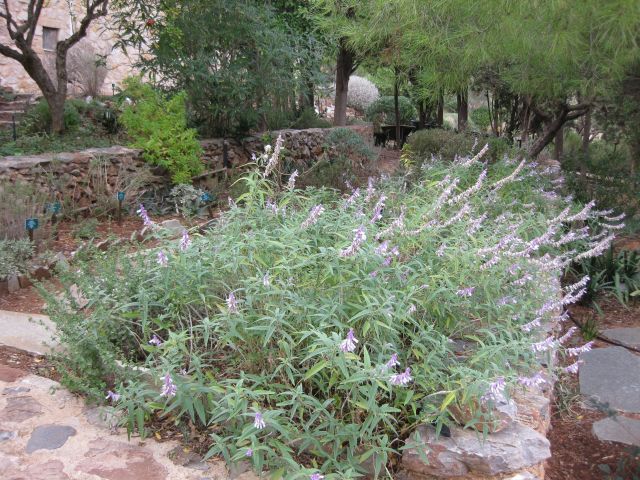
Salvia leucantha

Young Mandragora officinalis syn. M. autumnalis
Showing Sparoza to visitors is always a pleasure and very rewarding. Many find it helpful in planning their gardens, some inspirational, a number take notes and almost all take photographs with their little phones. One of the Australian members in her thank you note wrote: “I came away inspired on many levels, the garden, the philosophy, the plants, your library and your mind.” One needs a little ego-trip now and then!
My special greetings to Alessandra Vinciguerra whose visit to Sparoza is a happy memory.
Sally Razelou, October 2015.
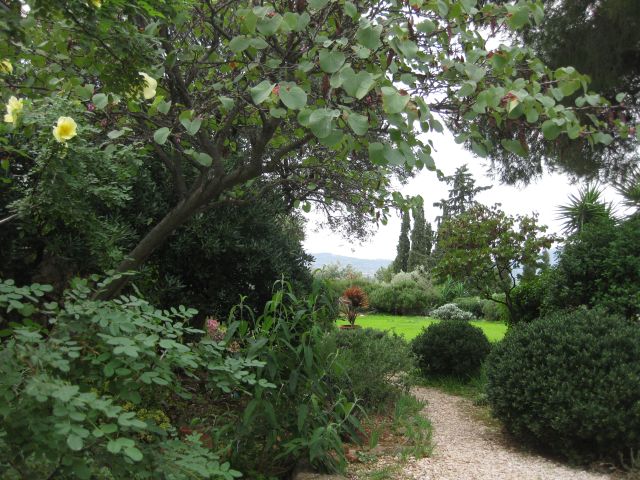
The threshing floor in its winter green
Photographs by Davina Michaelides. |
JANUARY 2014 |
The colours and scent of winter
This January was quite dry at Sparoza, but the good rains of late autumn and early winter were enough to trigger the best show of anemones on the hillside for several years. When Jacky Tyrwhitt bought her plots on this hill overlooking the Mesogeia Plain she could not have known what an exceptional spot it was botanically. Although then it was treeless and grazed by sheep, the variety of flora which has been found subsequently would be difficult to match anywhere in Attica. At the time of writing at the end of January, the multicoloured Anemone hortensis (syn. A. pavonina) and the dark blue Muscari commutatum are dominant.
At the beginning of the month swathes of Narcissus papyraceus scented the garden and the lower slopes of the hillside. While I find the perfume heavenly, our photographer, Vina Michaelides, cannot stay too long in the vicinity without being overpowered.

Narcissus papyraceus
We have a similar disagreement about the scent of another winter-flowering plant, Freylinia lanceolata, which has been blooming throughout January. To me it is like French perfume. This South African shrub was originally given to Sally many years ago by Heidi Gildemeister. Planted out in the irrigated terraces it languished and sulked and Sally assumed it disliked the alkaline soil. Consequently she kept a further gift of a sizeable container-grown specimen confined to its pot in the nursery. Then without warning the original plant stopped its nonsense, put on healthy growth and has become a pride of the winter garden with its ochre-yellow flowers. In fact it now looks so settled and happy that Sally decided to take a chance with the container-grown specimen and planted it out in the west bed bordering the house in the autumn. It has flowered well but will need special coddling during the summer until it forgets its soft life in the pot.
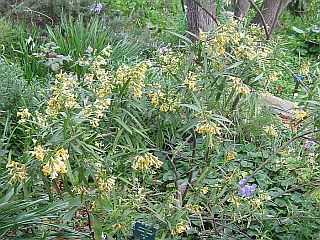
Freylinia lanceolata
Flowering now, the old favourite Buddleja officinalis has a pervading but easier aroma of honey which gets even profounder after sunset. Two specimens live in the terraces, for although this species adapts to the mediterranean climate better than the more usual B. davidii it needs regular summer irrigation. The plant is native to southern regions of China where the winters are mild and the summers hot but the rainfall is evenly spread. Buddleja officinalis will bloom for at least six weeks and then can be pruned back as severely as necessary to keep it within the confines of the space available. Left to its own devices it can grow to 4 metres in height and up to 5 metres in width.
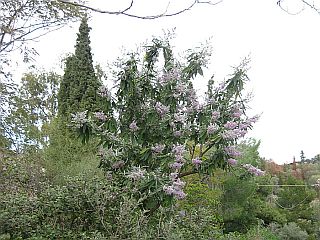
Buddleja officinalis
A low-growing plant with a scent so delicate that you need to bury you nose in the flowers – or more easily pick a bloom – is Iris unguicularis. Growing in and out of the terraces, the grass-like mounds become a mass of blue by the end of the month, some pale, some darker, all with interesting markings. This iris is native to the eastern Mediterranean and thus perfectly drought-tolerant, but it adds so much life to the terraces at this time of year that it is allowed to stay.
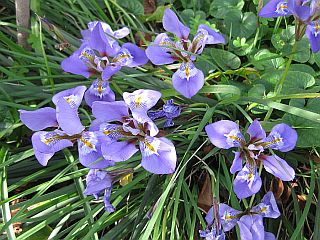
Iris unguicularis
Without scent, but an important plant for January flowering is Mandragora officinarum. Two mature plants in Derek’s Garden have taken up the mantle of the original mandrake collected by Jacky
Tyrwhitt (see Making a Garden on a Greek Hillside). Jacky identifies that mandrake as M. autumnalis but since it is flowering in January it is more to be likely M. officinarum. There are two species of mandrake growing at Sparoza: M. officinarum and M. officinalis, the latter previously known much less confusingly as M. autumnalis. Mandragora officinalis is the local species which can be seen growing again in the fields of Attica now that its ‘magical’ qualities are no longer sought after. As the old name indicates, this type flowers in the autumn and has finished by November. The flowers are dark blue and the leaf rosette lies flat on the ground. On the other hand Mandragora officinarum is flowering now, holds its leaves more upright and has a more faded blue colour.

Mandragora officinarum
Finally a note on the conclusion of two projects started in December. Isabel has restored the little terraces of Derek’s Garden, resetting the stones, building the soil up behind them and planting out new candidates for the harsh conditions of this patch of the garden.
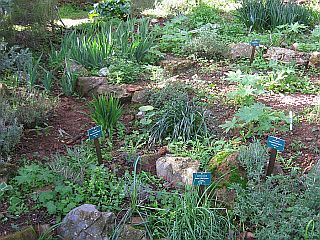
Derek’s Garden restored.
At the other end of the house, the island bed distinguished by slabs of marble has been totally replanted. It had been a wonderful display of Cotyledon orbiculata with its grey leaves and tall stems of hanging orange and yellow bells, but age and weather had spoilt their beauty and seedlings from the nearby Ailanthus altissima had embedded themselves among them. Just one corner plant of Cotyledon has been left and the rest of the space filled by succulents and other plants propagated in the nursery: Chlorophytum comosum, Aloe arborescens, Kleinia ficoides (grey fingers pointing upwards), Crassula ovata, Aeonium sp. (red-leafed rosettes), Ruschia perfoliata (grey knobbly stems), Kleinia grantii (red pompom flowers on long stems). A purchased red dracaena highlights the foreground while the young tree to the back of the bed was a gift from an MGS member and now gives its name to the bed, Oreopanax capitatus. According to the books, this is a small tropical evergreen tree from Mexico, Central America and the West Indies. It has very dense growth with large leathery oval glossy dark green leaves and many secondary branches. It reaches 5 to 10 metres in height. The small white flowers appear in thick stalked clusters from winter into spring.
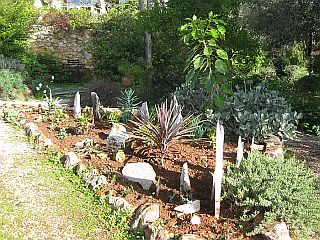
Newly-planted Oreopanax bed
Text Fleur Pavlidis
Photographs Davina Michaelides
|
JUNE 2012 |
Visitors to the MGS garden are still coming thick and fast despite the approaching summer. One young new member, Aris Zografidis, came to see what this place called Sparoza was all about. He was clearly knowledgeable about the native flora of Greece, but how would he react to the eclectic mix of plants gathered over the last fifty years first by Jacky Tyrwhitt and now by Sally, and to the ‘mature’ volunteers on a Thursday morning?
He writes: ‘The Greek sun of June, glorious, hot and merciless, has already sunk its bitter teeth into the unirrigated vegetation; yet beauty at Sparoza withstands it. This was my first visit to the garden and I was, to say the least, impressed by everything and everyone. And when I close my eyes I can still see blooming ptilostemons, bright pink Limoniastrum monopetalum shining in the midday light and Sally Razelou smiling at a petite oxalis.
Thank you very much! It was delightful to meet you all!’
During Aris’s visit we saw the full glory of the blossom on a tree in the terraces which had evaded identification for many years. This time, though, I knew what it was because it had just been identified on the MGS Forum: Tipuana tipu, a leguminous tree from Bolivia. And what’s more its history was recorded in Jaqueline Tyrwhitt’s book*. She writes: 'I got seed from a botanic garden in Israel and it grew fast into a rather willowy tree with long, light green leaflets and bright yellow pea flowers in June. My tree has not yet made pods but I think it is really a very good introduction to this area.'
*Making a Garden on a Greek Hillside by Mary Jaqueline Tyrwhitt, Published by Denise Harvey, Evia, Greece. 
Limoniastrum monopetalum.
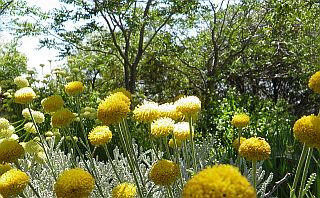
Santolina chamaecyparissus.
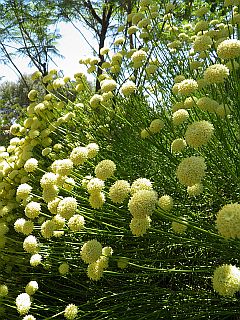
Santolina viridis.
|
APRIL / MAY 2011 |
When groups of students visit Sparoza there is a two-way learning process. This spring two groups were welcomed to the garden: 27 teenagers from a state school in a local town (for a report of this visit see TMG no 65) and about 15 mature students studying medicinal herbs.
The school children were recent converts to gardening and were involved in planting and caring for a strip of land next to the school. They were clearly hesitant beginners so it was our task to arouse their interest as well as to get over to them some basic principles. An illustrated questionnaire was designed to serve both purposes although the old adage of ‘you can take a horse to water…’ was proven yet again: “Why aren’t you correcting your answers?” “I couldn’t fill them in because I didn’t have a pencil.”
Most of children did take the visit seriously though and at the end could identify the common plants of the hillside whose names they already half knew and were starting to understand the relevance – if not the actual words – of the scientific names. (Just as an aside, on a recent visit to Cornwall I was tempted but finally did not buy a book called Wild Flowers of the Lizard because I discovered that the authors had spurned Latin names throughout in favour of Sheep’s Bits and Crane’s Bills. Local names are great for introducing the common plants to newcomers but to insist on using them alone to describe the whole flora of an area seemed more like a fetish.)
As well as learning names, having plants presented to them with reference to their drought-resisting qualities and being introduced to the basics of planting, mulching and pruning, the children were hearing Sparoza described over and over again as a garden and so were learning that a somewhat wild-looking space without lawns, topiary or fancy paving was indeed a garden and one much more in tune with the natural surroundings than the usual over-watered plots.
The mature students were more knowledgeable and like all garden visitors they enjoyed seeing plants they could recognize. Although making a collection of medicinal herbs has never been a priority at Sparoza, inevitably Greek native plants and medicinal plants have a huge overlap. Only Aloe vera stands out as an import and with Sparoza being full of various poorly identified aloes ‘hunt the vera’ was a good game. It was interesting to see the range of people doing the course – young men on motorbikes, grandmothers and career women among them. Apparently one way of inspiring an interest in plants, in urban Greeks at least, is to introduce the element of usefulness – learn about these plants because they have something substantial to offer you. Unsurprisingly though it became clear that our visitors could not resist the allure of mediterranean plants for their own sake and by the end of the evening visit an admiration of the salvia family was seriously installed in many of those I spoke to.
So from our two groups of visitors we learnt more of what it takes to motivate people, young and old, to take an interest in and appreciate plants. We learnt that ‘a visit is worth a thousand words’ and that by actually experiencing the alternative style of gardening demonstrated at the MGS garden, people’s acquired prejudices can be whittled away. Reasoned arguments against the extravagant use of water and for the use of climate-compatible, drought-resistant plants are so much easier to pursue successfully when you are standing in the midst of the achievement wrought by Sally on this uncompromising hillside.
Fleur Pavlidis
The answers to the questionnaire were supplied at the end of the visit on a sheet, illustrated in the same way as the questions, to be kept for reference. In case anyone has any doubts the answers are:
1 - a
2 - a, c, d
3 - Muscari
Ornithogalum
Iris germanica
Allium
4 - a, b, d, f, g, i
5 - 1. midiki
2. skino
3. faskomilia
4. asfaka
5. koutsoupia
6 - d
7 - a, c, d if the mulch is made of plant material rather than gravel or pebbles.
8 - c, d
9 - b or if the plant has attractive seeds or fruit when these are finished.
10 - a, c, e, g
11 - Teucrium fruticans ‘Azureum’
Cistus
Scilla peruviana
Coronilla |
JANUARY / FEBRUARY 2011 |
A new path through the phrygana under construction
As the visitor drives up the hill towards Sparoza, the first sight of the garden is the unfenced area of hillside which has become known as the phrygana. It is an area of the estate which is particularly appreciated for its richness in wild bulbs and annuals – some of which appear in great masses like Asphodelus fistulosa and A. aestivus, Cyclamen graecum, Anemone coronaria, Muscari commutatum and Silene colorata, while others are just abundant like Hermodactylus tuberosus, Urginea maritima, Gagea fistulosa and Prospero autumnalis (formerly Scilla autumnalis). And then there are the orchids and crocus which need a little searching out. For many years it was difficult to enjoy the phrygana because there was only one beaten track through it which rather went from A to B as quickly as possible. The clearing of a path through the wildest area in 2006 changed that and members and friends touring the garden can now wander to admire the flowers more closely without fear of treading on some precious specimen.
Such was the success of the path that Sally took courage to create another branch of it through the part of the phrygana which she has been quietly planting with drought-resistant trees and shrubs over the years. Although failures have been numerous, many of the successes have now matured. The new path winds through three brachychiton trees grown from seed by Sally when she first moved to Sparoza in the mid-1990s. They have reached a good three metres in height after several years of struggle. Then on past a group of Pistacia lentiscus in the midst of which we see an Aloe arborescens, ten years old but not yet managing to catch up with the lentisks and use them as support. Rosemary specimens and the two yuccas, Y. elephantipes and Y. gloriosa, mix with cypress, olive and pistachio nut trees to our right and to the left is a rarity - Phytolacca dioica, a gift from two members planted in 2008. This amazing tree, or more properly giant herb, can be seen fully grown in the National Garden in Athens. If we turn round at this point to see where we’ve come from a fresh aspect of the garden is revealed and even those of us lucky enough to visit the garden regularly smile at the surprise of a new delight and wonder at Sally’s unerring eye for composition. As the path swings left to join up with the existing one, young rosemary plants and new pockets of Iris germanica will help define the route, for this path will not be paved or even gravelled. The land has been levelled by removing the stones - the larger ones for use to mark the edge - and compacting the soil with a roller, but from now on only strimming will be used to keep it clear of tall grasses; otherwise it will return to the green of the hillside from autumn to spring and the dry crunchiness underfoot of the summer.
Fleur Pavlidis.
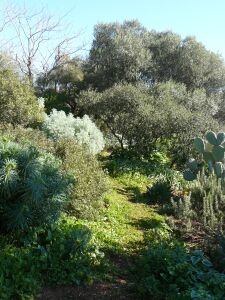
Planting in the phrygana which will be brought more
intimately into the garden by the new path.
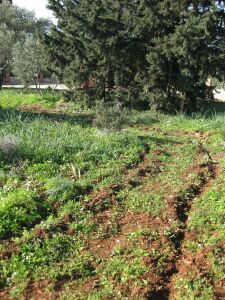
After Sally and her garden assistant Myon Yoo
had walked out the route of the path the width
was measured (using the classic broom handle
measurement) and the edges dug.
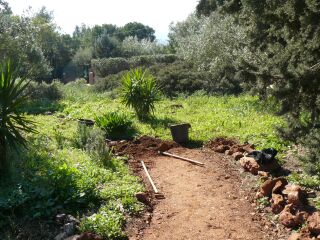
First the stones were dug out and put to one side for use as edging, then
the soil was raked and compacted.
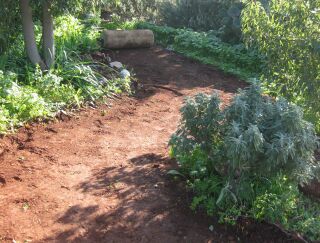
The red soil or terra rossa of the Sparoza hillside revealed. A recent
theory is that the terrra rossa found along the north of the
Mediterranean Sea is the build-up of millennia of wind-blown
soil from north Africa.
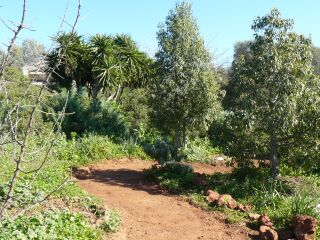
Looking back at the winding path through the brachychitons.
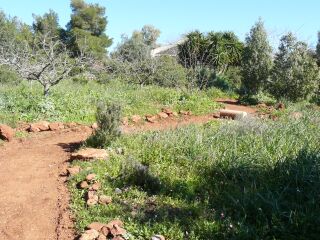
Looking back from further down the path.
Photographs by Davina Michaelides and Fleur Pavlidis.
|
OCTOBER / NOVEMBER 2010 |
Visitors to the garden
Much of the charm of Sparoza is that it was designed as a private garden. Sally Razelou, as the tenant, offered the garden to the MGS about ten years ago proposing that it would be maintained strictly as an example of MGS principles. She also offered the tiny flat at the side of the house as accommodation for student gardeners, each engaged for a 10-month period to be trained by Sally and financed by the MGS. First and foremost though, all and any member of the society would have the right to visit.
Since her generous offer Sally, instead of caring for her garden to her own rhythm as the rest of us do, has been working both as full-time 'head gardener' and as part-time tour guide. Many members accept the invitation to visit the garden, often making their appointment to coincide with the Thursday-morning session of volunteers so that they can get to know other MGS members in Greece.
The months of October and November saw a good mix of visitors. Some members used the fact of the AGM being held in Crete as an opportunity to visit Sparoza on their obligatory stop-over in Athens. Vice-President George Brumder and his wife Marilyn brought their long-time friend and renowned garden designer Isabelle Greene to meet Sally. The rest of the group stood back respectfully as the two of them crouched over a particular plant, viewing it, touching and smelling it and discussing its garden worthiness. Also passing through were members from the UK including MGS trip organiser Alisdair Aird, and Northern Californian Branch Head Bracey Tiede. For Greek members living outside the Athens area a visit to Sparoza has to be a carefully planned excursion. Couples from the island of Samos and from the southern Peloponnese made their way to the garden as did a young woman, also from the Peloponnese, who has set up a nursery there and spent many hours tapping Sally's knowledge about the plants happiest in our environment. A garden designer and her client, both MGS members, came to get ideas; British members living in France and Australians from Victoria took to the philosophy of Sparoza like - well perhaps ducks to water is inappropriate so let's say lizards to a warm rock. Finally because Sally believes she should encourage the fitting education of Greek gardeners she welcomed a group of mature students studying aromatic and medicinal plants with their teacher for an evening stroll with added propaganda about the MGS's principles.
The question is sometimes asked why the MGS garden at Sparoza cannot be more forward in encouraging visitors. Here is a mediterranean garden so important as a demonstration of how beauty is not dependant on an abundant use of irrigation, labour and commercial chemicals (to fertilize, kill and cure) so shouldn't it be used to spread the message? The answer of course is yes but there are ways and means like this very Diary which don't involve actual bodies in the garden - for it is certain that the garden as it is could not sustain a large influx of additional visitors. I'm afraid the location of Sparoza is carefully omitted in all articles about the garden or society in the local Greek press so that 'Sunday morning' drivers do not just turn up on Sally's family day. Coach loads of gardeners on tours from other countries would love to have Sparoza on their itinerary but this is too fragile an environment for the constant wear from large numbers. However it is hoped that members from outside Greece will take advantage the offer of the Greek Branch to help them organise group visits. The Greek Branch Heads can help with finding hotels and coaches and can give advice on other local places to visit. Please contact Frosso Vassiliades for information about member group visits and me for the usual appointments for members to visit (Sally has no email).
Fleur Pavlidis.
The MGS garden in October

Cyclamen graecum on the hillside.
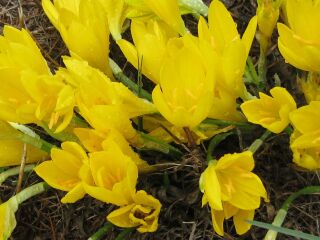
Sternbergia lutea.
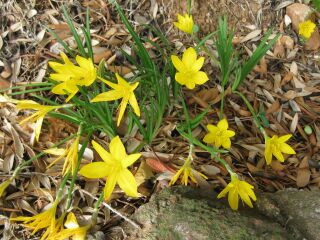
Sternbergia greuteriana – notice the narrower petals.

Aloe arborescens behind Oxalis purpurea.
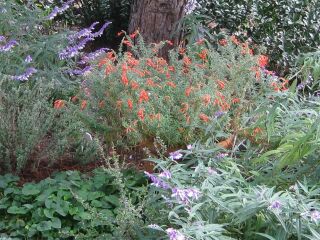
Epilobium canum in a pot flanked by Salvia leucantha.
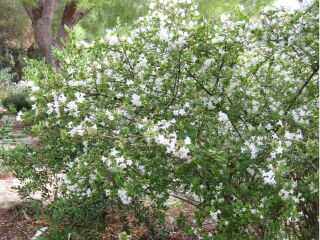
Abelia x grandiflora – pure white variety.
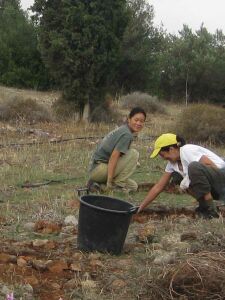
The new garden assistant, Myon Yoo, is fluent in
Greek, French and Korean as well as English.
Photographs by Davina Michaelides
|
SEPTEMBER 2010 |
End of Summer at Sparoza
At the end of September members Bracey and Richard Tiede from California visited the Sparoza garden for the first time. Here is their photographic reportage: a "no-frills" testimony of what an authentic waterwise mediterranean garden actually looks like before the advent of the beneficent autumn rains.
NB The irrigation pipes one can discern in some photos are left in place and used only when Sally Razelou decides to experiment in acclimatizing new plants in various parts of the garden.
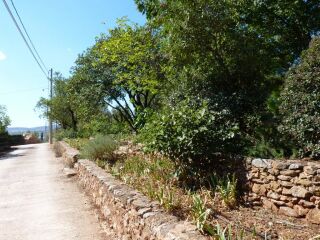
South road.
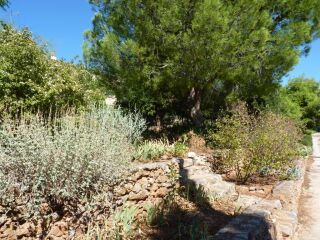
The road looking east.
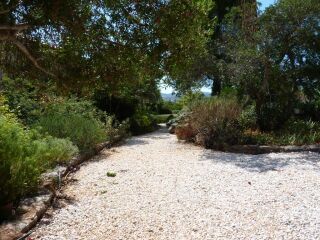
The drive.

The 'phrygana'.
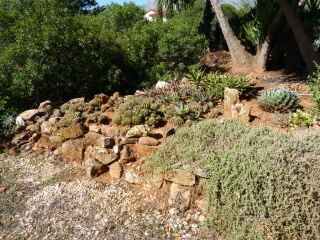
A border.
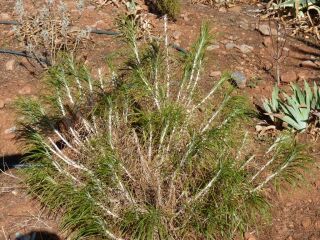
Ptilostemon chamaepeuce at the end of summer.
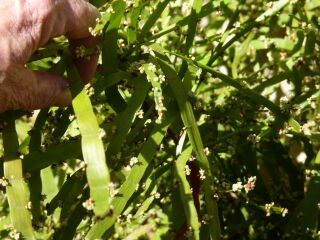
Homalocladium platycladum, ribbon bush from the Solomon islands.

Going uphill.
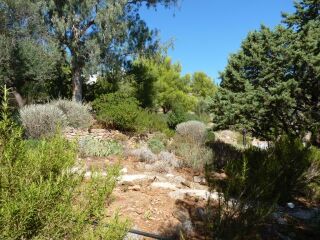
The hillside.
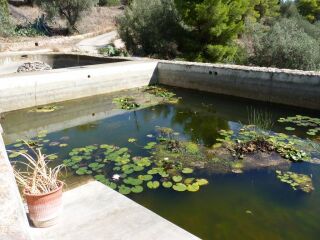
The pond at the end of summer.
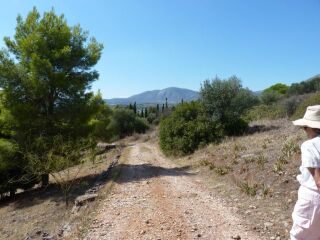
The dry road.
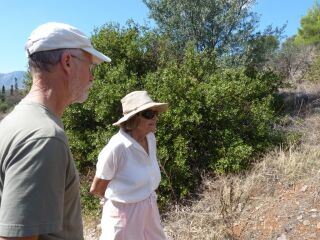
Sally with Richard
|
AUGUST 2010 |
Hot Sun and Hard Landscape
I wonder if there is any beast which 'hibernates' through the summer – which sleeps the endless scorching days away in a cool hideout. If so I think there were plenty of us in Attica this year who would gladly have joined him. As heatwave merged into heatwave and night temperatures never dropped below 30 degrees, life itself became an endurance test, let alone gardening.
At Sparoza the summer means no garden assistant. Assistants are engaged for a 10-month term which ends at the end of June, thus excluding the height of summer. Similarly the volunteers pack up their trowels and gloves in July and don't regroup until after the first autumn rains. By the time the workers leave the garden it is ready for the summer – the dried grasses long since cut, the flowering shrubs dead-headed, the seeds of the annuals collected and their dried-up remnants dumped into the compost pits. The beds and gravel paths have been weeded and the watering system checked. So, as the lush growth shrivels and colours fade, the shapes and surfaces of the garden become more prominent and we see how dependent the Sparoza garden is on its stone walls.
Attica is extremely rocky and for most of history the country cottages could be built simply by picking up stones from the surface of the land, particularly from gullies. Another good source was abandoned buildings – including ancient ones. If extra stone had to be dug out it was from a local quarry – every village had one. Yet with the introduction of cement, a very cheap resource in Greece, building in stone went into a steep decline. Stone masons turned into cement pourers and bricklayers and no young men were learning the trade. By the 1960s building by stone was in the hands of a few old craftsmen and only a handful of people had both the aesthetic vision to insist on using local stone and deep enough pockets to pay for a craft which had gone from everyday to rare and expensive. Fortunately Jacky Tyrwhitt was one such. As you can see from the plan of the estate the plot slopes in two directions and the house is built across both slopes. The glorious reddish brown stone blasted from the hillside to make way for a lower floor and foundations was undoubtedly the mainstay of the materials used for the house itself, but was mainly used outside for the tall retaining walls and walls to support the terraces and demarcate the beds in the garden. The rough stone unites the house and garden into one entity and embeds them as 'natives' in the hillside, to use an analogy from the plants in the garden. It is these stone walls which give the 'cultivated' (as opposed to wild) part of the garden its shape and personality. They provide support for climbers, protection from cold and wind for more delicate plants and, most importantly I think, a backdrop for the plants in the beds – apparently unobtrusive yet actually rooting them in their environment.
As a footnote I would add that with the opening of the border between Albania and Greece in the 1990s, a flow of cheap labour moved southwards including many experienced stone masons. It has turned out that the availability of cheap cement had only repressed the love of stone temporarily and with the revival of the art of masonry many villages in Greece have been transformed by the restoration of old stone houses, by new stone walls and doorways and indeed by attractive new stone houses.

Sally Razelou welcoming guest Leonard Grant. Flower beds hug the walls
on either side of the entrance.
Photographed by Michelle Torres Grant in October 2004.

The house wall criss-crossed by Macfadyena unguis-cati.
Photographed by Chris Wassenberg in October 2009.

The walled garden unfortunately has no romantic hidden entrance.
Photographed by Anthony Rees in January 2005.
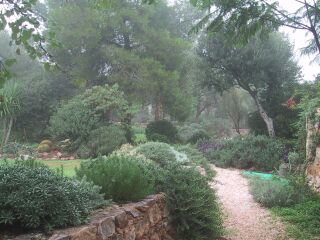
A pleasing curved wall retains the ‘threshing floor’ on the opposite side of the path to the walled garden.
Photographed by Cali Doxiadis in October 2006.
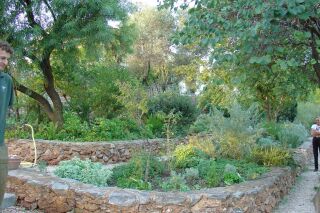
The ends of the top terraces.
Photographed by Michelle Torres Grant in October 2004.

The land drops away at the back of the house.
Photographed by Anthony Rees in January 2005.
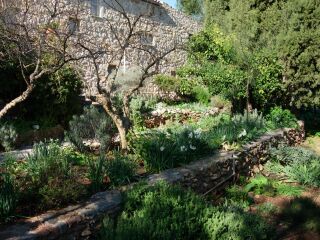
Part of the house is two storeys tall.
Photographed by Anthony Rees in January 2005.

The low wall enclosing the desert bed gives protection to a wild
Barlia robertiana syn.
Himantoglossum robertianum growing outside it.
Photographed by Davina Michaelides in March 2008.
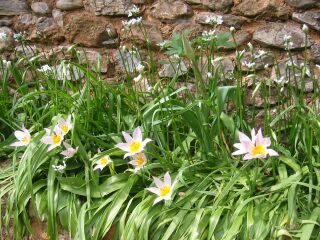
Stone as the perfect foil for Tulipa saxatilis and Allium neapolitanum.
Photographed by Davina Michaelides in March 2008.
|
MARCH 2010 |
As the warm wet winter turned into a warm dry early spring, the garden at Sparoza was stunningly beautiful. Niggling worries about the lack of spring rain were put to one side because heavy downpours would for once be unwelcome. Sally, Peter and the volunteers worked tidying and tweaking to get everything in the garden ready for the great event – the making of a full-length video of Sally in the Sparoza garden.
It had been a dream of many of us that a record of Sally's garden should be preserved on film and suddenly all the necessary elements were in place: the cost was covered by a generous grant and a member/film-maker was ready and willing to do the job. Terry Moyemont, who has been a friend of Sally and visitor to Sparoza for many years, was a professional film-maker before turning into a nurseryman and the Head of the Pacific North West Branch. For ten days he combined his two loves, basking in the pleasure of filming the garden in all the shades of light from dawn to dusk and shadowing Sally as she went about her tasks. At the same time he took a huge number of still photographs, some of which are reproduced below.
We call it 'the garden at Sparoza' or 'the MGS garden' or even sometimes 'Jacky Tyrwhitt's garden' but let there be no mistake that this is Sally's garden. Miss Tyrwhitt founded it and the MGS sponsors it but in effect the garden as it is now is a pure expression of Sally's love, inspiration and skill. In the terraces she mostly has single specimens, each one positioned with knowledge and care, and described like a friend. "The original plant of this was given me years ago by Heidi Gildemeister" she tells you of an Eriocephalus africanus. "The mandrakes in Derek's garden came from the M…s' on Syros." Yet the plants are ruthlessly dug up and moved on if they prove too brutish or fail to thrive. Meanwhile the hillside becomes richer with the introduction of plants which have proved their drought-worthiness yet still the natural feeling of the phrygana is maintained.
We wait with impatience to see how Terry has captured Sally's garden on film.
And already Sally is planning for the autumn when the new garden assistant will arrive: what will move, what will stay and what will be sent "up the hillside". Terry has photographs from his previous visits but now they are historical records – visions of a garden which was beautiful but different.
The MGS would like to express its sincere thanks to the Stavros Niarchos Foundation whose grant made the filming of Sally's garden a reality. The film will be available to members in October 2010.

A view of the phrygana below the house.
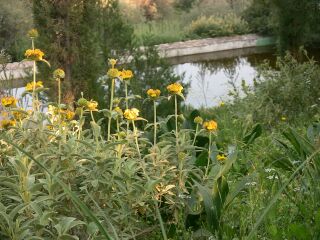
Phlomis fruticosa by the pond.
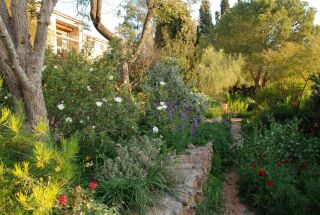
Along the terrace.
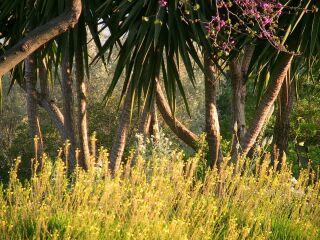
Bulbine frutescens ‘Hallmark’.

Crocosmia species.
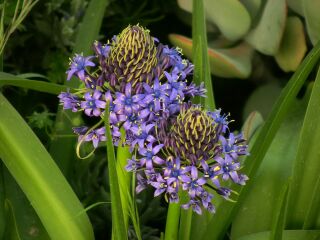
Scilla peruviana.
|
FEBRUARY / MARCH 2010 |
The Mediterranean Garden at Sparoza: a perfect mixture of Greek native and introduced mediterranean-climate plants in a natural setting. Photographs by Davina Michaelides.
I should like to thank Nate Benesi for identifying the unknown acanthus as Acanthus sennii, a shrub form Ethiopia where it is now rare.
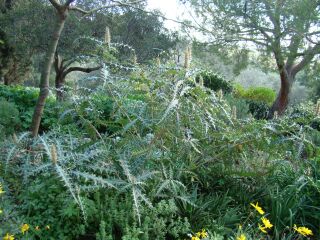
An unidentified Acanthus, possibly sub-tropical since it needs
irrigation,
in bud in the terrace. It loses it leaves in the summer.
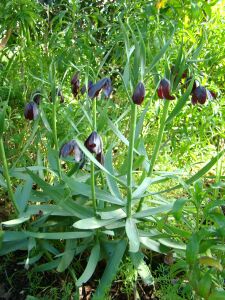
Fritillaria obliqua. Native to Greece
and collected for Sparoza.
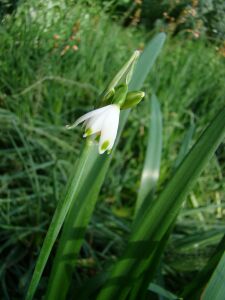
Leucojum aestivum, Snowflake. Native to parts
of
Greece. Introduced at Sparoza.

Tulipa saxatilis, Rock tulip. Native to Crete, Karpathos and Rhodes
and introduced and multiplying at Sparoza.
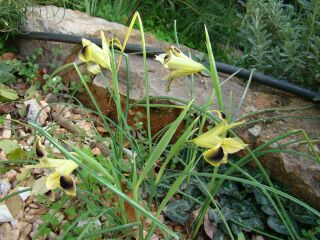
Hermodactylus tuberosus syn. Iris tuberosa, Widow iris.
Native to most of Greece and wild at Sparoza.
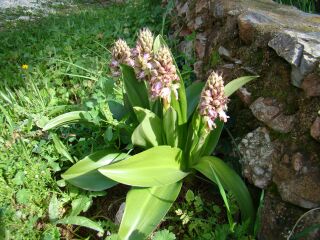
Barlia robertiana syn. Himantoglossum robertianum,
Giant orchid. Wild at Sparoza.
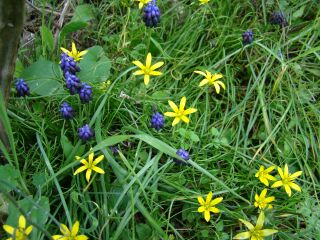
Gagea fistulosa and Muscari commutatum wild on the hillside.
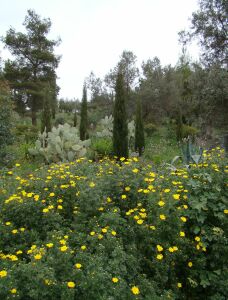
Chrysanthemum coronarium wild on the hillside.
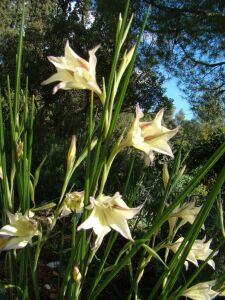
Gladiolus tristis, a wonderfully scented
flower from South Africa.

The terrace with two garden cistuses: white Cistus ladanifer
var. petiolatus f. albiflorus, which accepts lime in the soil,
and
pink C. x argenteus ‘Peggy Sammons’
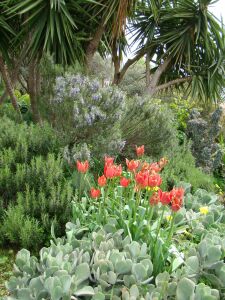
Tulipa boeotica syn. T. undulatifolia, a Greek native
collected for Sparoza, among a winter-flowering
Cotelydon hybrid and Rosmarinus officinalis
which is widely naturalized in Greece.

A Crocosmia species from South Africa growing in front of a wild
Acanthus mollis at the foot of Yucca elephantipes from Mexico.

Coronilla glauca ‘Citrina’, a cultivar bred from a Greek native,
spilling out of the front bed.
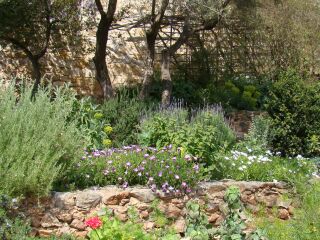
Lavandula dentata from the western Mediterranean with
Phlomis russeliana from Turkey, Salvia disermas from South Africa
and Osteospermum jucundum also from South Africa.
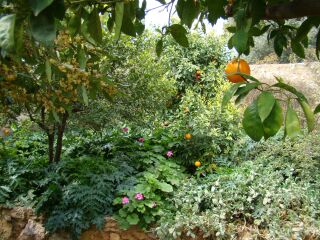
The walled garden with an abundantly flowering bay tree and
Acanthus balcanicus, a species native to the Balkans introduced
and naturalized at Sparoza.
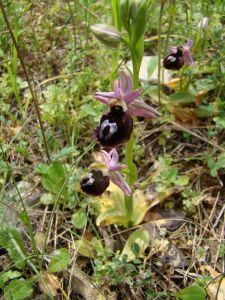
Ophrys ferrum-equinum, Horseshoe orchid,
wild on the hillside.
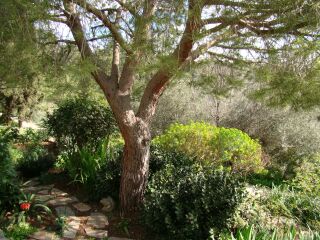
A medley of calm greens of Greek natives amid the spring colour:
Pinus halepensis, olive, Euphorbia dendroides and Ruscus hypophyllum
with Viburnum tinus flowering in the background.
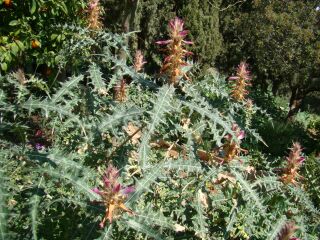
The acanthus now in flower. Any ideas about the identity of this plant
would be gratefully received.
|
FEBRUARY 2010 |
This winter, while our members in northern Europe and even in the south of Spain and France suffered from prolonged snow and cold, here in Attica we were enjoying a wonderfully mild wet season. The lightest of frosts when a little snow fell on the surrounding mountains has been the worst so far. February came in with a bit of a cold snap but soon the temperature was spring-like again, encouraging the wild flowers into a frenzy of blooming. The soil was damp to a good depth, as proved by how easy it was to pull up the weeds. But as the month progressed without any more rain we feared that an early drought might spoil the spring pleasures.
At Sparoza pruning was one of the major jobs; shrubs like artemisia, previously dead-headed, were cut back into shape and the roses were pruned, although not the lovely Icebergs. Sally has found that her Icebergs do not respond well to pruning and get weaker rather than strong if pruned hard. Some of the olives on the estate hadn’t been touched for ages, so throughout the first two months of the year Peter Dinning set to with the saw to bring them to order and pile up logs for the fire.
Unfortunately the good weather encouraged the Oxalis pes-caprae to spread as never before and all the garden help was engaged at one time or another in digging it up. With the soil so friable it was sometimes possible to get the plants out whole with bulbs and bulbils still attached to the end of the stem – but how frustrating when they then dropped off and disappeared back into the soil to reproduce next year. Although the oxalis grows most luxuriantly in the improved soil of the beds, it is also making its way into the wild.
Asphodelus aestivus makes a marvellous show but it has become too rampant at Sparoza. As mentioned before, Sally has turned this into an advantage by letting the asphodels create planting pockets for her. Digging a hole in the rocky hillside is an arm-jarring job but digging up an asphodel is relatively easy and the holes left are just ready to be filled by something else - Narcissus papyraceus this time.
One of the plants that attract compliments from visitors to the garden is a dark blue-flowered teucrium – Teucrium fruticans 'Azureum'. Planted in an irrigated terrace, this plant reproduces by suckering and Sally is able to use the young suckers to grow on in the nursery for plant exchanges. Out in the phrygana the same plant prospers without any summer water but does not sucker at all, perhaps to conserve its energy.
Both Cyclamen graecum and C. persicum have self-seeded in the garden this year. Sally has grown cyclamen from seed on many occasions but it was a pleasure to see these strong little plants being potted up in the nursery; of course there is a certain satisfaction in getting something for nothing but more basically it is seeing nature melding with the artificialness of a garden.
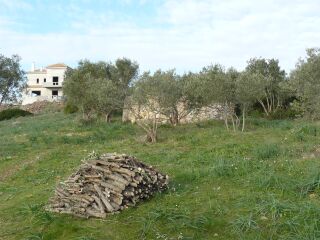
Olives planted 40 odd years ago to mask the water cistern, after pruning.
(Fleur Pavlidis)

Oxalis pes-caprae at the foot of the hillside.
(Fleur Pavlidis)
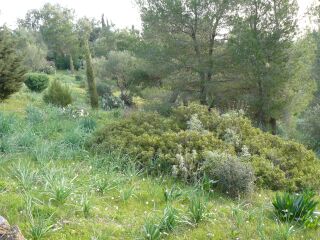
Asphodelus aestivus on the rampage.
(Fleur Pavlidis)

Teucrium fruticans‘Azureum’ in full flower
in the first week of January.
(Davina Michaelidis)
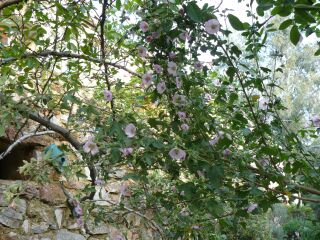
The mild weather has meant that this Anisodontea malvastroides has
flowered throughout the winter.
(Fleur Pavlidis)
|
NOVEMBER 2009 |
In November and December the queen of trees at Sparoza is the Rhus lancea and this year the blossom was the best ever - the whole tree came alive with the dropping sprays of yellow '‘flowers'. As we stood admiring the picture, it struck me that the terraces below the house are now in the shade of a variety of mature trees. Some of them are well known to friends of the garden like the row of cypresses planted by Jacky Tyrwhitt as a windbreak at the north end of the terraces, and the pomegranate trees whose fruits - so gaily-coloured – have been photographed by many visitors. The fruit of the bitter orange trees in the same terrace is mentioned for its good marmalade qualities by Jacky Tyrwhitt in her book. Then there are the dancing olives. These are two trees which were cut back to the ground before Sally Razelou’s time and grew back again with multiple trunks. The patterns of the trunks, kept clean of branches for the first 1.5 metres, give the feeling of movement. The heart of one has been planted with a Cyclamen persicum shown in the Diary in February. The 'Golden Rain Tree' has never been identified to Sally’s satisfaction – Sophora japonica is the best guess.
Now in autumn the leaves of the Ulmus parvifolia and Cercis siliquastrum (Judas tree) are on the turn and starting to drop, as are those of the Ailanthus altissima at the south end of the terrace. Some visitors are surprised to see this tree, usually categorised as an invasive foreigner, given a place at Sparoza. Sally has it in a bed of its own where the smooth silver trunks are shown to full advantage and she values it as a decorative garden tree. This seems to be the female of this dioecious tree as it does not have the masses of unpleasantly smelling flowers of the male, in fact the tree seems to be sterile and does not flower at all. There is still a problem with suckers but compared with the effort required to cull seedlings it is not that great.
Two other non-Europeans are a self-seeded Parkinsonia aculeata and a Grevillea robusta. The latter can only grow as tall as the gap between really hard winters will allow, but it never gives up and comes back from ground level after each great frost.
Finally some natives: a Pistacia lentiscus in the middle terrace has been 'lifted' and grown as single-trunked tree to allow for planting underneath. This gives it an unconventional appearance since the lentiscus is usually a ground-hugging bush, made more so when they are chewed close by sheep and goats which graze in the wild in Greece. A Rhamnus alaternus has been similarly pruned into a tree. A Pinus pinea (Stone Pine), initially so useful as a mask for the airport in the Mesogia Plain below, has now grown out of proportion in the terraces and adds proof that masking is best performed by open screening rather than by a solid block. As always, the decision to fell a mature tree is one of the most difficult – as we should remember before we plant any tree destined to outgrow its position.
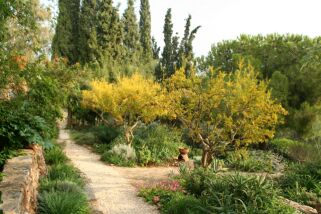
Looking towards the cypresses we see the pomegranates,
the
Parkinsonia aculeata and the over-grown Stone Pine.
Chris
Wassenberg, who took this photograph in 2006,
thinned out the
branches of the pine whilst he
was Garden Assistant.
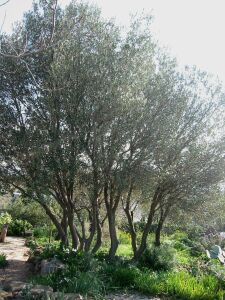
The dancing olives.
Photograph by Davina Michaelides.
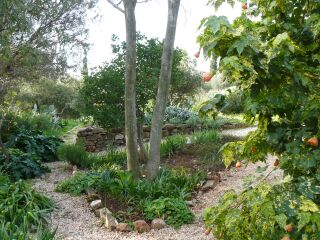
The trunks of the Ailanthus altissima.
Photograph by Fleur Pavlidis.
|
SEPTEMBER 2009 |
The beginning of September at Sparoza is all expectation as Sally awaits the first rains and the next Garden Assistant. They arrive almost synchronously and the new gardening year takes off.
Peter Dinning comes to Sparoza having spent all his working life in horticulture in the UK. I asked him to give me his impressions after a month in what he described as his new career. His first comment was on how much he was enjoying the climate and the relaxed atmosphere and why the two were connected. He explained how in the UK the weather was so variable that if a task needed to be done in particular conditions then there was great pressure to get it completed before the conditions changed. In the mild month of September at Sparoza though, jobs had simply continued from day to day without stress. He had learnt from his previous employment in large elegant gardens to be tidy and careful with his tools but had been frustrated by the requirement to have every growing part of the garden always in perfect order. He preferred the more natural approach at Sparoza where even in the beds wild flowers and random seedlings are often welcomed and plants are frequently left to grow as they wish. There were many plants in the garden and on the hillside which were quite new to Peter and which he was looking forward to studying, but even the plants he was familiar with were growing differently and needed different treatment. In general he realized that he had much to learn but hoped soon enough to be able to contribute suggestions to the garden’s development; he had already understood that Sally was open and receptive to his ideas, which was quite a change for him from working under strict landscape designers.
The month ends and summer has returned without any further rain having fallen on Attica although elsewhere the grapes are rotting on the vines because of the constant downpours. Will October see the rain clouds coming our way?
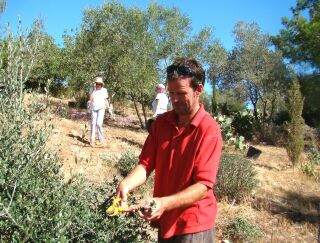
Garden Assistant Peter Dinning working on the hillside with Sally
and a volunteer in the background.
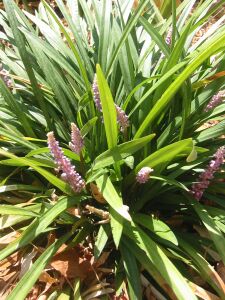
Sally plans to plant more Liriope muscari in the shady part
of the garden among the Iris japonica which flower in spring.
|
AUGUST 2009 |
As August comes to an end and we await the first autumn rains, Sally Razelou tells me that she has maintained the garden (and house) since the last rains at the beginning of May with a remarkably low 78 cubic metres of water. She will describe her irrigation regime for 2009 in a future issue of The Mediterranean Garden, while my mind now turns to what I know about the changes in the watering system in the garden.
When the hillside terraces where first constructed, cement irrigation channels were fashioned along the edge of each one as an adaptation of the traditional earth channels used for centuries by farmers in their vegetable plots. Such a channel is visible in the photo below. Jacky Tyrwhitt watered by means of these channels when the terraces were first planted, but after a few seasons it became clear that they were too inflexible and wasteful of water so hand-watering had to take over.
Coming forward to 2000, the MGS had taken over the garden more formally and was financing a garden assistant and the purchase of many new plants. Hand-watering became too time-consuming so a drip irrigation system was installed throughout the terraces, in some of the front beds and up the hillside. Apart from on the hillside, the system used double-walled perforated piping rather than individual drippers and was controlled automatically by a 4-programme, 12-circuit timer. Unfortunately the system relied on the water pressure created by having the water cistern at the top of the hill so the watering pipes on the hill which were supposed to irrigate the newly planted trees never delivered sufficient water. In addition, within a few years the hard water from the well started to fur up many of the perforations in the pipes and sections of the beds were left dry.
By then, however, the whole philosophy of mediterranean gardening was changing and we were at last accepting the fact that daily and even weekly watering had to be reserved for pots and vegetables in the former case and for a small proportion of the plants in our gardens in the latter. Heidi Gildemeister’s waterwise approach was leading the way. Sally therefore declined offers to renew the system, preferring to make do with a combination of systems, part old, part new, with sprays and drippers; eventually the entire garden was watered by hand as described in July 2008, while the volume of irrigation water used was reduced. By 2008 it was down to 73 cubic metres. Now was the time to strike a balance between water consumption and plant variety. The number of deaths occurring showed clearly that many mediterranean plants could not survive without help in the harsh conditions of Sparoza, so in 2009 Sally returned to an irrigation system more finely tuned this time to the plants and controlled by her rather than by an automatic timer so that each circuit could be given the water needed. Now at the end of August the plants do not have the lush appearance achieved by abundant watering, they are hardened and quiet but surviving to come awake again in the October “spring”.
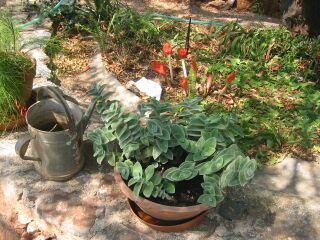
A close up of the cement watering channel, long since disused,
taken in September when the Haemanthus coccineus is just appearing.
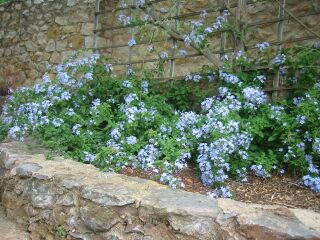
Plumbago auriculata flowers profusely with a little irrigation.

At the end of August the Amaryllis belladonna suddenly opens.
It has been bone dry all summer.
Photographs by Davina Michaelides
|
MAY 2009 |
In most of Greece May made little pretence of being part of spring this year. The earlier cool, wet weather had provided us with an abundance of wildflowers for our May Day wreaths but almost immediately the temperature rose into the 30s and summer had arrived. Sally recorded a few drops of rain at Sparoza on 6th May but from then on the phrygana quickly turned from green to brown and by the second half of the month it was time for mowing. Many people regret the passing of the scythe — in skilled hands the grass could be cut quite quickly with a graceful swish. Now anyone with strength enough can get out the motor strimmer and amidst much noise and dust another unpleasant job is done. Young Antoine Quelen, on placement from the landscape architecture college at Blois (ENSNP), was “volunteered” for the task this time. The volunteers themselves took on the weeding of the gravel path which runs through the triangular section of phrygana below the house, so that by the end of the month the whole area had taken on its tidy summer appearance.
In the beds the self-sown annuals bloomed their last and were then fed to the compost pit. Sally spread seeds from the larkspurs and delphiniums into the phrygana but knows that their performance there will be quite different from that in the garden proper — their growth stunted and their flowers short-lived. Late spring flowers of phlomis, salvias, echium, wallflowers, rose and lampranthus kept the garden looking gay despite the gaps where the annuals had been. How to deal with the gaps left after the annuals have finished is one of the challenges of a mediterranean garden. Here at Sparoza an area shaded by trees where the larkspurs seed and grow is planted thickly with autumn bulbs, Zephyranthes candida and Belladonna lilies (Amaryllis belladonna). Sally has also tried agapanthus as a filler but finds that in full sun its leaves are bleached to an unappetizing grey colour. Other solutions are lacking at the moment apart from actually using the gaps as part of the design of the summer garden.
There was a happy surprise in the nursery when Sally spied an unusual looking ‘weed’ growing in the gravel. It turned out to be a seedling of a Mexican annual brought to the nursery some time ago but subsequently lost. With thistle-like leaves and oenothera-like flowers it is a strange little plant called Argemone ochroleuca.

Students from the ENSNP at Blois,
Antoine Quelen and Joséphine Pinatel.
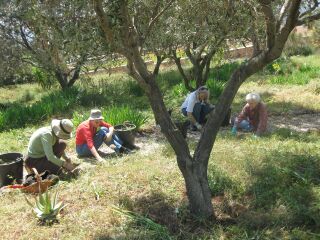
The volunteers at work weeding the gravel path.
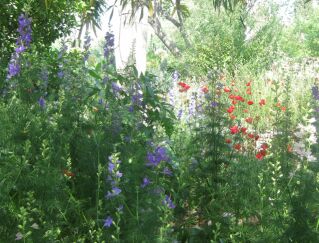
Consolida spp and Papaver rhoeas in the shady part of the garden to be
followed later by Zephyranthes candida and Amaryllis belladonna.
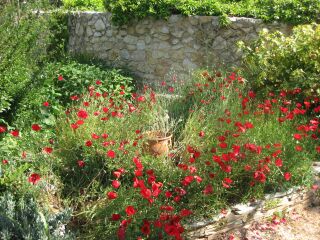
These poppies are not growing in a bed but in a paved area where the
stone flags sit in soil. It will revert to a sitting area at the end of the month.
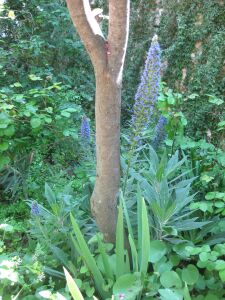
Echium candicans growing in a pleasing contrast
with the trunk of an Ailanthus altissima.
This
tree, often despised for its invasive disposition,
is used very effectively at Sparoza.
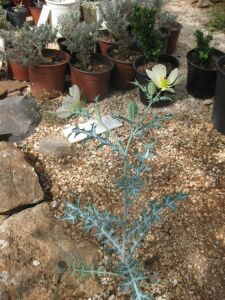
Self-seeded Argemone ochroleuca.
Photographs by Davina Michaelides
|
APRIL 2009 |
Many years ago when we were planning an MGS exhibition in Greece, the President, Katherine Greenberg, suggested the title Out of the Wild and Into the Garden. Those plans never bore fruit, but in fact there is an exhibition that could go by that name every April at the MGS garden at Sparoza. The hillside phrygana is the ultimate wild garden − flowering fit to burst; green shoots covering every shrub; a feast for the eyes, nose and emotions.
Of course this is a garden. All the trees have been planted by Jacky Tyrwhitt or Sally, as we can tell from the old photos of a stripped, bare landscape. The Pistachio lentiscus have been clipped and the phlomis dead-headed while the oat grasses are constantly pulled up before they seed and the grass cut as soon as it dries up. And of course Sally constantly adds plants here and there, trying them out for appearance and suitability. Some take to the phrygana conditions without complaint − the bearded irises for example. Others may survive as long as they have the help of the introductory watering but then fade away. Sally doesn’t insist by replanting the same plant and changing the care regime. The majority of the new plants have been propagated in the nursery so she knows that the failure will not have been due to bad root development but to lack of resistance to the harsh conditions. She notes the result and moves on to try something else, letting nature be her guide.
As I was buying some potting soil from my local nurseryman this month I noticed that he was loading up lawn turfs. I looked at him askance and could not stop myself remonstrating. He shrugged his shoulders and replied simply: "Some people have money and think they are God". Well, the Sparoza garden is run on a shoestring and Sally regards herself as a servant rather than a god, or rather as a custodian of the beauty of spring.
Some of the spring treasures in close-up:

Campanula drabifolia

Lomelosia brachiata (syn Scabiosa brachiata)
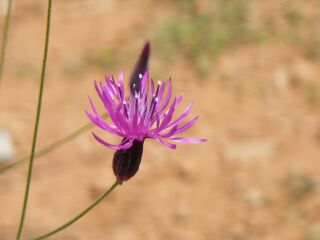
Crupina crupinastrum

The Ornithogalum arabicum has seeded itself all around the garden –
and paths – so Sally is encouraging it to move on to the hillside.

April is the month when we remember the crucifixion, yet it is the Judas tree
(Cercis siliquastrum) which brightens the countryside. This specimen in the
garden has attractive purple seed pods from summer to autumn.
|
JANUARY 2009 |
A good beginning to the gardening year as the rains continued and the weather stayed cold but above freezing. Although in terms of millimetres (75.5) the amount of rain has not been as much as in some previous years, the kind of weather has been ideal − the rainfall has been steady and regular with few storms heavy enough to cause the water to run off unabsorbed. Even on dry days the skies have been cloudy and the atmosphere so heavy that transpiration has been limited. Not great for the rheumatism but the ground has stayed soft and damp − comforting for the plants which were suffering by the end of the long summer drought.
On the hillside the anemones are back; they're at least a month late and, as Sally remarks, rather stunted in the length of flower stalk, but just as many as ever. It's a relief. Another happy piece of news is that the Aleppo pines (Pinus halepensis) are almost free of caterpillar nests this year. They were thoroughly cleaned by the garden assistant, Jane Shaw, last year and the effect is notable. Down in the village, trees which were obviously neglected are covered in nests and the processional caterpillars (Pytiocamba) will be on the march soon enough.
The terraces at Sparoza are always changing as Sally removes some plants which have outgrown their position and divides and thins out others. Dead subjects are replaced and a whole terrace gets a new look. This year the bed surrounding the 'threshing floor' suffered a number of drought casualties, including the large Ptilostemon chamaepeuce pictured in the June 2008 diary entry and visible as a dead mass in background of the December 2008 photograph of Agave americana 'Marginata'. The ground has now been cleared and the new residents are waiting to take their places.
We won't mention the Oxalis pes-caprae − the bane of the volunteers' lives − but end on the sweetly-scented Cyclamen persicum which is now at its best. The original plant which has been a feature of the garden for many years has been joined by two others, brought from England by Jennie Gay and planted up close to the trunks of a pruned olive − a combination so natural and satisfying that one longs to replicate it.

The anemones are back, here growing on the hillside path
which is edged with the trunks of long-dead pines.
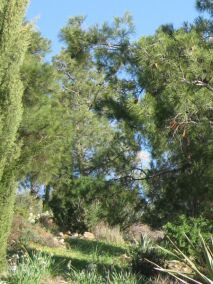
Healthy Aleppo pines (Pinus halepensis).
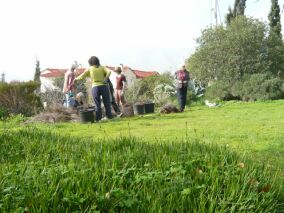
The volunteers clearing away the dead wood round the
'threshing floor'.
Photograph by Maria Paraskeviades.
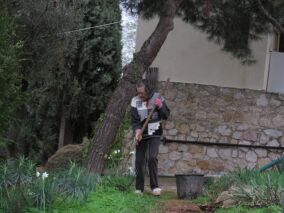
Sally Razelou in her best working clothes weeding outside
the gardener's annexe.
Photograph by Christa Vayanos.

Dull days have meant less transpiration. Meanwhile the
Oxalis pes-caprae crowds out any natural vegetation.
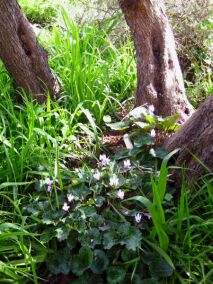
Cyclamen persicum planted under an olive.

As long as the temperature is not below freezing for a prolonged period,
the faithful variegated abutilon flowers on all winter.
|
DECEMBER 2008 |
Where are the anemones?
The last month of the year brought plenty of rain and frequent warnings of frost and snow although the latter fortunately did not affect the Sparoza garden. Sally was able to continue work, planting out using plants propagated in the nursery. As the autumn-flowering Cyclamen hederifolium faded away the Paperwhites (Narcissus papyraceus), first introduced into the garden by Jacky Tyrwhitt and since planted throughout the phrygana by Sally, began their pure white display and their heavy perfuming of the air. The bulbs multiply so readily that in any garden a few will soon become a mass.
But what about the anemones? Anemone coronaria has always been one of the glories of the hillside, blooming in the depths of winter in a profusion of colour, yet this December they are marked by their absence. I consulted Making a Garden on a Greek Hillside to check Jacky Tyrwhitt's experience only to find that she too describes them as a glory which started blooming in December and continued until at least February.
One of my embarrassing memories from living at Sparoza as a young woman was running out to remonstrate with a group of village women who were gathering anemones by the armful. Only later did I learn that this was an established custom in the countryside that no pesky foreigner − not even the respected Jaqueline Tyrwhitt − could influence.
Sparoza is no longer part of the countryside nor would the ladies of Peania thank you for calling them village women (horiatisses), yet the strange urge to cut huge quantities of wildflowers can still be observed in Greece − primroses, poppies and orchids cut by the dozen and then left to wilt and die in the car. Profusion breeds complacency but if the anemones can disappear from the protected environment of Sparoza the omens are not good. We wait impatiently to see if it is just that their flowering is very late this year due to the lack of rain in the earlier part of autumn, hoping that the anemones will show themselves in January.

If only our computers could transmit the wonderful perfume
of Narcissus papyraceus.

A large Iris unguicularis was divided during the propagations
workshops held at the 2007 AGM Symposium and the smaller
plants have not yet got back into their full flowering swing.

This cultivar of Teucrium fruticans has particularly striking dark
blue flowers: another plant to brighten the winter.

A pot of Sedum kamtschaticum is a classic sight
in Greek courtyard gardens. It is a wonderfully tough
plant that can survive long periods of drought in its
pot without looking too miserable.

The variegated Agave americana 'Marginata' makes an interesting
backdrop in this dry bed throughout the year.
Photos by Davina Michaelides |
SEPTEMBER 2008 |
September came in this year as it should, with days of soft, penetrating rain. Sally excitedly recorded the millimeters on her chart as the garden broke into its ‘second spring’. Imperceptibly the plants started to look more alive and then colour reasserted itself as blooms reappeared –Sternbergia lutea, Zephyranthus, Amaryllis belladona, Tulbaghia violacea and Cyclamen graeca among the bulbs, and roses, bougainvillea, Ceratostigma plumbaginoides, Pavonia hastata and Liriope muscari among the herbaceous plants. Only those plants whose survival is in the balance will need a little longer to show signs of life. Suddenly in a terrace bed we can seethe exotic Haemanthus coccineus – deep scarlet flowers coming and going before the huge rounded leaves emerge.
As the month proceeds seedlings of Cerinthe retorta and Delphinium staphisagria start to appear en masse, to be thinned and left only where they can grow unfettered. Unfortunately an unwelcome guest also returns. In the lists of harmful invasive plants (some of which are mentioned in TMG 54), South African Oxalis pes-caprae does not rank very high since farmers are not much bothered by it, but it is one of our greatest garden pests. Forty years ago Jacky Tyrwhitt was relaxed about letting it spread in her garden at Sparoza because she enjoyed the yellow flowers in spring and Sally has been battling against it ever since. The effects can be unexpected. In an attempt not to recycle it through the garden, the pulled oxalis along with other weedings from affected beds is gathered for the rubbish rather than the compost heap. This means that the compost mix is short of soft waste matter and the natural breakdown of the hard wood prunings etc is retarded. Without a male garden assistant (or indeed any garden assistant) this year to introduce a little ‘activator’ into the compost heap (see Compost-making at Sparoza TMG 39), piles of unrotted waste accumulate. “Perhaps the neighbours would give us their grass mowings” was the heretical suggestion of one of the volunteers. For yes indeed, the Sparoza hill is now dotted with villas sporting gardens which grow in defiance of the natural setting – the olives, orchids and stones having been replaced by leylandii cypress, lawns and pools.

The shy Liriope muscari is one of the first plants
to flower after the rains.

Haemanthus coccineus from South Africa – a totally hardy
exotic in the terrace.

Will this artemisia revive?

An unusual white Thevetia peruviana in a pot to the south of the house
has been blooming all summer long.
Photos by Davina Michaelides |
JULY 2008 |
Dead or Alive
As the summer progresses we are grateful in Attica for a cooling breeze which keeps the temperature below heatwave levels, but the air carries no moisture and the thirsty plants are obliged to put up their drought-stress defences. By July in Sparoza the phrygana has gone into summer dormancy – the medics (Medicago arborea), tree germanders (Teucrium fruticans), Jerusalem sage (Phlomis fruticosa), Euphorbia characias ssp. wulfenii, helichrysums and cistus are in their natural desiccated state. They look as if they are dead or dying but in fact they are surviving - though they differ from their sisters in the wild in being neatly dead-headed and clipped into shape. Fortunately there are other plants for which their dormant state does not mean loss of colour: on the hillside the cypress, lentisks (Pistacia lentiscus), Cneorum tricoccon, Rhamnus alaternus and of course the pines set off the spiky dryness of the desiccated greys. Yet Sally is always vigilant.
Having ditched the inefficient automatic watering system which we had been planning to renovate this year, Sally is experimenting with ‘emergency room’ watering all done by hose and hand. Plants regarded as totally drought-tolerant are nevertheless watched for signs of over-stress. Some rhamnus, spiraea and even lentisks and a small Arbutus unedo, after two statistically dry winters, have shown signs of succumbing to stress and have been given emergency water rations to save them. Meanwhile less drought-tolerant plants, mostly in the terraces, are given deep watering (that is, as far as you can call it deep when the underlying rock is so close to the surface) every so often. But throughout the garden there is a feeling of stillness - no lush growth, no fresh green weeds nor any abundance of flowers. In fact at this time of year bright colour is mostly confined to the pot plants in the true Greek manner. Alas, Sally no longer uses feta tins but I somehow feel we should find some for her to give her entrance a true national flavour.

A clipped medic next to a green Pistacia lentiscus with a dormant
Euphorbia acanthothamnos in the background which shapes itself naturally into a cushion.

The Cneorum tricoccon is reliably green in the summer. Beside it towards
the back a Convolvulus cneorum looking good but with the help of regular water.

One of the few flowering plants, Plumbago capensis, plus visitor.

Not all the plants are dead-headed. Here the Ptilostemon chamaepeuce looks
handsome with its dried flowers, as does the Cotyledon orbiculata

Sally’s daily task.
|
MAY 2008 |
April and May are the months when Sparoza is home to students on placement from the French Ecole Nationale Supérieure de la Nature et du Paysage of Blois. Due to the relative isolation of Sparoza for those without personal transport, Sally Razelou generously offers places to two students so that they have company.
The students are normally young and inexperienced but under Sally’s close guidance they learn the practice of mediterranean gardening and are helped to identify the plants both in the garden terraces and growing wild on the hillside. Sally also takes them ‘botanising’, usually near the archaeological sites around Athens. Being almost invariably artistic, the students produce reports for the college which are beautifully illustrated by their line drawings and watercolours. And of course they take some excellent photographs, a few of which appear here.
The two months see a valuable exchange – the garden has extra hands during the busy spring period and the students absorb knowledge about the demands of a mediterranean garden and the way it can be designed to incorporate the natural landscape alongside beds and terraces.
After the prolonged spring the heat arrived suddenly as it always does and the spring flowers immediately ran to seed. By the end of May the dry vegetation in the phrygana had been cut and the estate was taking on its summer feel. Formerly Sally preferred to hand-pull the dry grasses to protect the wildlife – in particular the ladybirds. However this labour of love became too labour-intensive and the grass is now cut using a petrol-motored strimmer. The garden is an example of the theory set out by Cali Doxiadis in A Summer Dilemma, TMG no 50. To counteract the lack of colour and excitement in the summer garden Sally keeps it scrupulously maintained: all the gravel paths are weed-free, the bushes are neatly pruned, the flowers dead-headed and the plant rubbish cleared up. It helps of course to have the weekly attendance of the volunteers who are willing to unwind and chat whilst performing these repetitive tasks.
See also News and Views.

Marie and Eloyse.

View up the hill on 12th April 2007 taken by Eloyse.

Erysimum “Bowles’ Mauve’ taken by Eloyse. Sally makes them flower a second time
by removing the flowers just as they start to fade. They make a wonderful flower
arrangement in a low pot.

The flower of Euphorbia acanthothamnus taken by Marie.

The flower of the pomegranate taken by Marie.
Photos by Marie Gallienne and Eloyse Descurninges

Poppies seeded into the gravel paths, 9th May 2008.

This amazing yucca is home to myriads of small birds.

The upper terrace in its lush spring verdancy on 18th April 2008.
Photos of 2008 Yannick Campion and Elodie Petra |
APRIL 2008 |
Styrax officinalis
A large deciduous shrub native to Italy, Greece, Turkey and California with sweet-scented white flowers which open in late spring. This makes an attractive garden plant though I have never seen it in a nursery. If properly grown it needs no summer irrigation. Despite its size it should be planted where the light fragrance will drift across a path rather that at the distant back of a bed. In the MGS garden it grows next to the lower road.
Botanically, it is interesting. The bark gives a resin which has been used for medicinal purposes. Arthur Gibson notes: " Uses of natural products from bark of Styrax date back at least to the Sumerians, who incorporated the terpenoid resin storax into a variety of medicinal preparations, such as liniments and ointments, applied to sores, aches, and infections. Some accounts say that the inner bark was crushed, and then hot water was used to extracted the terpenoids, whereas others mention boiling the bark and skimming the insoluble resin scum before pressing the inner bark for more extract. From that storax is refined into an opaque liquid having the viscosity of honey and the fragrance of balsam."
This was known in ancient Greece where Theophrastus gave the plant the name Styrax which has remained unaltered ever since. In the 1750s, Linnaeus described Styrax officinalis known to him from the wild in Southern Europe. It turned out to be also a native shrub of Southern California, Styrax officinalis L. var. redivivus (Torrey).
Arthur Gibson again: "Three decades ago there was extensive discussion about intercontinental disjunctions. Certain genera and a handful of species have very large discontinuities in their range, some having gaps of ten to twenty thousand kilometers. Styrax officinalis is one of those, being at approximately the same latitude but nine time zones away: California to Italy. This has been termed by Dr. Thorne (in 1972) as the Mediterranean-American disjunction. How and when the populations of this species became so separated is still a matter of speculation, because there are other plants of the Mediterranean region that have very closely related species in California. Other species of Styrax also occur in North America; for example, there are four native species in the flora of Texas, and the many of species in the genus are native to eastern Asia. The only reasonable conclusion is that this genus was once widely distributed across the Northern Hemisphere and became restricted to certain smaller zone."
Fleur Pavlidis
(1) ARTHUR C. GIBSON, MEMBG Director, Newsletter Spring 2002 Volume 5
(2), Mildred E. Mathias Botanical Garden UCLA

|
FEBRUARY 2008 |
After several weeks of mostly bleak winter weather, the meteorological office forecast snow for the south of Greece – snow which would settle.
Right on time the storm came and for three days the garden was covered with up to 30 cm of snow. Sally and her assistant Jane had prepared for it by covering many of the less hardy plants with fleece, and when the snow thawed it appeared that not much damage had been done. Yet as the days passed more and more parts of the affected plants turned brown and by the end of the week many were looking very burnt, though probably not dead.
The worst affected were: Duranta erecta, Homolocladium platycladum, Clerodendrum floribundum, Leonotis leonurus, Pavonia hastata, Carissa macrocarpa, Eriocephalus africanus, Tecomaria capensis, Salvia discolor, Echium candicans, Myoporum laetum, Crocosmia, Clivia and Ornithogalum nutans.
The Melianthus major which had made such a show in 2007 lost its large leaves but the flower buds were unharmed.
While the terraces were left looking generally rather sad, the wild flowers took precedence and the hillside burst into colour with anemones, Muscari commutatum, Cerinthe retorta, Silene and numerous white and yellow daisies and marigolds. Hermodactylus tuberosus (the Widow Iris) appeared in the paths where it has self-seeded profusely and a collected specimen of Fritillaria obliqua in one of the beds is now proudly in bud.

Snow on the terraces.
Jane Shaw

It took several days for the Crocosmia leaves and flowers to turn completely brown.
Jane Shaw

The Salvia discolor, in flower just before the snow, may not have survived despite being covered.
Jane Shaw

Muscari commutatum with its characteristic two-toned flowers.
Davina Michaelides

Hermodactylus tuberosus has spread from the hillside into the garden.
Davina Michaelides

Although locally abundant in the wild, Fritillaria obliqua is hard to grow as a garden plant.
Davina Michaelides

The sweet pink of this Helleborus orientalis caught the photographer’s eye.
Davina Michaelides
|
JANUARY 2008 |
A few notes on how bulbs at Sparoza have responded to the climate conditions of 2007.
Probably as a result of a period of drought in the early months of the year, none of the spring crocuses flowered in 2007, nor did Tulipa saxatilis. After an exceptionally hot, dry summer, the autumn Crocus goulimyi flowered as usual. Sternbergia lutea and Narcissus serotinus flowered normally in the autumn. However, Amaryllis belladonna was clearly unhappy with the summer heat and drought, and produced not a single bloom in autumn 2007 – a striking difference from its usual profuse flowering in the phrygana area to the south of the main garden. Now in January it has clumps of lush foliage. In contrast, Narcissus papyraceus responded very well to its summer baking and is flowering better than ever before all over the garden and the hillside. On the hillside Arisarum vulgare and Anemone coronaria are also profuse.
We have been planting a drift of new rosemaries in the phrygana area. All the rosemaries are covered in flowers, including those planted by Jaqueline Tyrwhitt when the garden was first created in the 1960s.
Sally Razelou

Clumps of lush foliage of Amaryllis belladonna,
unfortunately surrounded by Oxalis pes-caprae
an invasive weed from South Africa.

Narcissus papyraceus – Paperwhites - flowering
better than ever before all over the garden.

Arisarum vulgare on the hillside.

An old rosemary covered in flowers.

The January morning sun.
Photographs by Davina Michaelides
|
|


